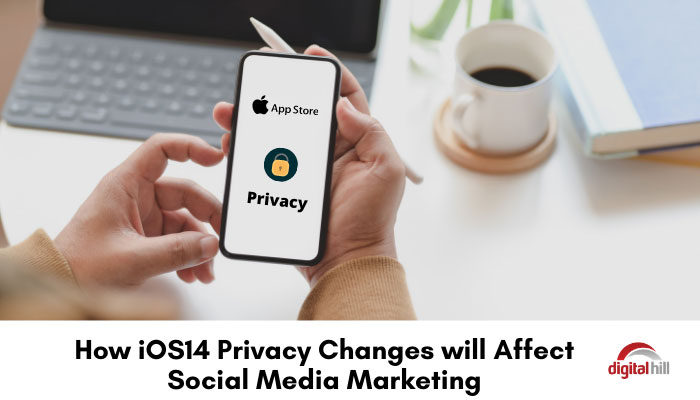How iOS14 Privacy Changes will Affect Social Media Marketing

On September 16, 2020, Apple released iOS v14, one of the company’s most significant OS updates to date. The new OS introduces an array of positive changes aimed at increasing convenience for iPhone users. Among other things, iOS v14 arrives with a redesigned home screen, several innovative features, updates to existing apps, and Siri improvements. Not to mention many other tweaks that streamline the iOS operating environment. As well as iOS14 privacy changes.
Furthermore, the updated OS also introduces several new security features. These will significantly tighten rules around user location and data sharing as Apple seeks to give users more control over their personal data.
These privacy restrictions, though much-needed, are likely to substantially impact how marketers interact with iPhone users. Generally, marketers may need to gain more permissions and be a little more transparent about the data they collect. If you’re just learning about the iOS14 privacy changes, this is what you need to know.
The Main iOS14 Privacy Changes
There are two main changes in the new iOS. IDFA now requires users’ explicit permission, and users can now select a broader, less specific location.
IDFA settings changes
Apple’s Identifier for Advertisers (IDFA) was launched in 2012, creating an individual user ID supporting cross-device data tracking for third-party advertising.
Up to iOSv13, advertisers could leverage the IDFA to collect useful data, including device ID, name, email address, and more from the moment the user installs the advertiser’s app. No restrictions barred them from collecting this data even if the user changed phones. Indeed, advertisers weren’t even obligated to inform the user that an IDFA had been set.
That trend changes with iOSv14. Now, Apple will now require advertisers to ask users if they want to share their IDFA. The user can accept or decline the request.
Location settings changes
Many apps also require the user’s location to function properly. Unfortunately, some advertisers have exploited this provision in the past to track specific users’ movements and offer targeted ads based on the particular location.
Apple iOSv14 makes a small tweak to this provision by introducing an “Approximate Location” option. If the user doesn’t wish to share their precise location, they can toggle off “Precise Location” and activate the approximate location.
Potential Impacts on Social Media Marketing
There are several other privacy changes in the updated Apple iOS, many of them well-intended. The following are a few ways these changes might impact social media marketers.
- Impact on measurement and attribution: The new “Approximate Location” changes will severely hinder the ability to track iPhone users’ precise locations, making the measurement of in-store foot traffic more difficult.
- Tracking new users may become a little challenging: Many marketers rely on the last-click metric for channel attribution. With the introduction of “Approximate Location,” it may be difficult to tell if users are new or returning customers.
- Location-based targeting will be affected: With the changes to IDFA and location settings, targeting users based on precise locations may become a lot harder. The success of such campaigns will now hinge on the user’s willingness to opt into IDFA tracking.
- There’s a need to be more convincing: With more power in the users’ hands, marketers have an even bigger job. Previously you rely on IDFA to get the data you need without breaking a sweat. Now you’ll now need to convince users to sign-up, subscribe, and opt-in to your marketing campaigns.
When Do the Changes Kick In?
Apple recently told developers that it plans to delay the enforcement of the privacy changes in iOSv14. However, nearly all the changes will still likely come into effect in early 2021. This will mean you’ll likely want to evaluate your marketing strategy and see if any changes need to be made on ad spend and ad platforms used.